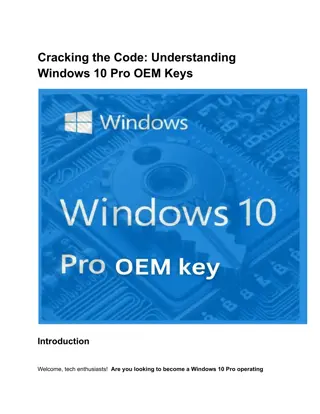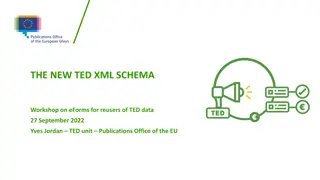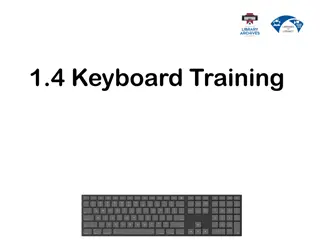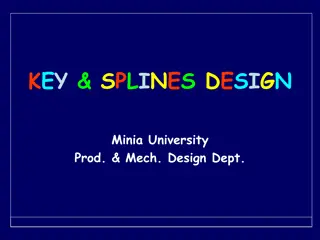Schema Evolution and Foreign Keys: Research Insights
Evolution of foreign keys in relational schemata over time and the importance of designing for schema evolution. Delve into the patterns of schema growth, impact on surrounding applications, and the historical context of schema studies."
Download Presentation

Please find below an Image/Link to download the presentation.
The content on the website is provided AS IS for your information and personal use only. It may not be sold, licensed, or shared on other websites without obtaining consent from the author.If you encounter any issues during the download, it is possible that the publisher has removed the file from their server.
You are allowed to download the files provided on this website for personal or commercial use, subject to the condition that they are used lawfully. All files are the property of their respective owners.
The content on the website is provided AS IS for your information and personal use only. It may not be sold, licensed, or shared on other websites without obtaining consent from the author.
E N D
Presentation Transcript
Schema Evolution and Foreign Keys: Birth, Eviction, Change and Absence Panos Vassiliadis, Michail-Romanos Kolozoff*, Maria Zerva, Apostolos V. Zarras Department of Computer Science and Engineering University of Ioannina, Hellas * Currently @ Upcom, Hellas http://www.cs.uoi.gr/~pvassil/publications/2017_ER/ http://www.cs.uoi.gr/~pvassil/projects/schemaBiographies/
Research Question In the context of schema evolution, how do foreign keys evolve over time? 2
Why is schema evolution so important? Software and DB maintenance makes up for at least 50% of all resources spent in a project. Databases are rarely stand-alone: typically, an entire ecosystem of applications is structured around them => Changes in the schema can impact a large (typically, not traced) number of surrounding app s, without explicit identification of the impact. Is it possible to design for evolution and minimize the impact of evolution to the surrounding applications? But first, we need to know the patterns of evolution of relational schemata! 3
Why arent we there yet? Historically, nobody from the research community had access + the right to publish to version histories of database schemata Open source tools internally hosting databases have changed this landscape & We are now presented with the opportunity to study the version histories of such open source databases Mind the gap! (15 years) Curino+ ICEIS08 Univ. Riverside IWPSE09, ICDEW11 Qiu,Li,Su FSE13 Un. Ioannina CAiSE14, Cleve+ SCP15 Un. Ioannina CAiSE17 , ER17 Sjoberg IST 93 ER15 ~ ~ 1993 2008 2009 2011 2013 2014 2015 2017 4
Why arent we there yet? In all previous attempts, the object of study was the schema size as well as the heartbeat of change, Patterns on table behaviors have been studied only lately. To the best of our knowledge, the current paper is the first comprehensive effort in the literature to study the evolution of foreign keys. Mind the gap! (15 years) Curino+ ICEIS08 Univ. Riverside IWPSE09, ICDEW11 Qiu,Li,Su FSE13 Un. Ioannina CAiSE14, Cleve+ SCP15 Un. Ioannina CAiSE17 , ER17 Sjoberg IST 93 ER15 ~ ~ 1993 2008 2009 2011 2013 2014 2015 2017 5
What we have found for schema evolution [CAiSE 14, IS 15] Schema growth over time (red continuous line) along with the heartbeat of changes (spikes) for two of our datasets. Overlayed darker green rectangles highlight the calmness versions, and lighter blue rectangles highlight smooth expansions. Arrows point at periods of abrupt expansion and circles highlight drops in size. [IS15] 6
What we know so far for table evolution [ER 15, IS 17, CAiSE 17] 7
Setup of our study Scope & generalization: Collected histories (i.e., sequence of versions) of relational schemata being part of free open-source software (and not proprietary ones) coming with fairly long history different domains, treatment of foreign keys, growth over time Domains Science (Atlas, BioSQL) Computational Resource Toolkits (Castor, Egee) CMS s (Slashcode, Zabbix) We should be very careful to not overgeneralize findings to proprietary databases! 8
Toolset Some preprocessing was occasionally needed to allow the parsing of schema histories Used out homegrown toolset to extract changes Hecate, a tool to extract the history of changes for tables https://github.com/DAINTINESS-Group/Hecate Parmenidian Truth, a tool to extract the history of changes for foreign keys https://github.com/DAINTINESS-Group/ParmenidianTruth Parmenidian Truth is also able to visualize the schema history as a PowerPoint/video file All the data are available at: https://github.com/DAINTINESS-Group/EvolutionDatasets 10
Using a graph metaphor for evolving schemata with FKs (bonus: the story of Egee in one slide) 11
What we dont know yet How do FK s evolve? Do tables and foreign keys evolve in sync? When & How do FK s germinate & die? as we will see, these questions led to unexpected results and more insights on how developers deal with foreign keys Also studied [not part of the paper]: graph properties of tables and their relationship to evolution 12
Context and background Setup of our study Main findings Strange things happening with FK s Lessons learned, open issues & why bother MAIN FINDINGS 13
Evolution of Tables & FK s Tables grow in all cases (known from previous research) with periods of slow growth, calmness, spikes of extension, and occasional cleanups Foreign Keys are treated with different mentalities. 3 families: Scientific Comp. Toolkits CMS s 14
Evolution of Tables & FKs: Scientific projects Tables and FKS grow in synch, in both cases Growth comes with expansion periods, shrinkage actions, and periods of calmness in terms of both tables and foreign keys. 15
Evolution of Tables & FKs: Computational Resource Toolkits Tables and FKS grow little and slowly; for Castor, not exactly in sync Castor: observe how scarce FK s are (too few tables come with FK s, see vertical axis) 16
Evolution of Tables & FKs: Content Management Systems (CMS s) FK scarcity: really big at Slashcode, moderate at Zabbix Slashcode started without foreign keys at all; 1stset of FK s in v. 74. Zabbix seems to show a certain degree of syncronized growth Yet, both CMS's end up with no FK s!! -> see next 17
What an unpleasant surprise: developers can resort in full removal of foreign keys! Slashcode: there is a clear phase of progressive removal Zabbix: abrupt removal of almost the entire set of foreign keys in a single transition (unexpected based on how FK s had been treated till then) We dedicate some explanations in the sequel 18
How do FKs germinate and die? We classified FK s births and deaths in 4 categories Births Born with table: when either the source or the target table is born along with the foreign key, Explicit addition: when a foreign key is added to two existing tables. Deletions Died with table: when either the source or the target table is removed along with the foreign key, Explicit deletion: when neither of the source or target tables gets deleted and only the foreign key is removed. 19
Stats on FK Change Atlas, Biosql and Egee (less) deal with FK s as regular part of the schema FK s are, to a large extent - Born with tables - Removed with tables 21
Stats on FK Change Castor & Slashcode (both with a really small minority of FK s) deal with FK s as an ad-hoc add on: FK s are mostly explicitly added/ removed Zabbix has a mixed style: explicit del. and add. w. tables (& a sudden style change) 22
Families of developer profiles wrt the treatment of Foreign Keys Integral part of schema: fairly large pct of tables involved in FKs, grow in sync with tables, germinate and die with them Disposable Add-on: small pct of tables involved in FK s, explicit additions and deletions, easy to remove them (in some cases, entirely!) Mixed: can be with a change of style 23
Heartbeat of change Birth & deaths are proportionally spread in time -- except Atlas. The volume of change is typically low: most changes ~ 1 FK. Exceptions: (a) explicit mass add & del, (b) do-undo actions (Atlas, Slashcode and Castor), and, (c) restructuring due to table renamings (4 in Biosql, 2 in Zabbix). 24
Percentage of transitions with FK change Common theme in all the data sets: the consistent scarcity of FK changes Scientific data sets: short active period + treatment of FK s as an integral part of the schema (births and deaths of tables and FK s in sync) => high pct of transitions with FK change The rest: FK b&d are rare and explicit (w/o mass removals, would be even less) 25
Characteristics of the heartbeat of schemata wrt Foreign Keys Scarcity of FK change: expectedly very few transitions come with FK change, except for idiosyncratic cases Low volume: typically 1 FK change at a time, except for mass add/del Birth & deaths are proportionally spread in time Occasional do-undo and restructuring due to table renames 26
Context and background Setup of our study Main findings Strange things happening with FK s Lessons learned, open issues & why bother THE MYSTERIOUS CASE OF THE DISAPPEARING FOREIGN KEYS 27
Slashcode: the disappearing FKs At the end of its studied history, and via a progressive removal period, the schema is left with zero foreign keys. Interestingly enough, the schema also contained zero foreign keys at its start. Quite importantly, Slashcode's behavior holds both foreign key additions and deletions mostly happening explicitly (i.e., without the addition or removal of the involved tables). In other words, it appears that foreign keys are treated as a disposable add-on that was removed when problems occurred. 29
Slashcode: the disappearing FKs 1stmassive foreign key removal (rev 1.120), 22 FK s deleted. 2ndmassive deletion (rev 1.151), 10 FK's deleted 3rddeletion (rev 1.174), 3 FK's deleted 4thdeletion (rev 1.189) 1 FK deleted 5thdeletion (rev 1.201) 1 FK deleted 30
1stmassive foreign key removal (rev 1.120), 22 FK s deleted. "Commented-out foreign keys are ones which currently cannot be used because they refer to a primary key which is NOT NULL AUTO INCREMENT and the child's key either has a default value which would be invalid for an auto increment field, typically NOT NULL DEFAULT '0'. Or, in some cases, the primary key is e.g. VARCHAR(20) NOT NULL and the child's key will be VARCHAR(20). The possibility of NULLs negates the ability to add a foreign key. <= That's my current theory, but it doesn't explain why discussions.topic SMALLINT UNSIGNED NOT NULL DEFAULT '0' is able to be foreign-keyed to topics.tid SMALLINT UNSIGNED NOT NULL AUTO INCREMENT" "Stories is now InnoDB and these other tables are still MyISAM, so no foreign keys between them." 2ndmassive deletion (rev 1.151), 10 FK's deleted 3rddeletion (rev 1.174), 3 FK's deleted "This doesn't work, makes createStory die. These don't work, should check why..." "This doesn't work, since in the install pollquestions is populated before users, alphabetically" 4thdeletion (rev 1.189) 1 FK deleted 5thdeletion (rev 1.201) 1 FK deleted "This doesn't work, since discussion may be 0." 31
Slashcode: what did the comments say? The main problem seems to be the difficulty of developers with the tuning and handling of both foreign and primary keys. Sometimes difficulties are hard -- e.g., different storage engines, typically due to performance reasons Some difficulties are complicated due to technicalities like autonumbering Sometimes fixes could be found with some effort (e.g., changing the order of table population, or using numeric data types for primary keys, or inserting some goalkeeper values at FK target table) 32
Slashcode: what do we make out of this case? The main problem seems to be the difficulty of developers with the tuning and handling of both foreign and primary keys. Practically, it appears that the easiest way out of this kind of problems is to comment out the respective foreign key. So, removals of foreign keys went on as a regular practice, instead of attempting to fix the problems. This simply states that the essence of the contribution of foreign keys in the consistency of the schema does not seem to outweigh the need to quickly get things done. 33
Scarcity of Foreign keys A 2013 collection of schema histories, lists 21 data sets, -- some have more than one target DBMS variants. $ cd RESEARCH/Github/EvolutionDatasets $ ls -d * */* CERN CMS's/Coppermine CERN/Atlas CMS's/DekiWiki CERN/CASTOR CMS's/Joomla 1.5 CMS's/e107 Med/biosql CERN/DQ2 CMS's/NucleusCMS CERN/DRAC CMS's/SlashCode CERN/EGEE CMS's/TikiWiki CMS's CMS's/Typo3 CMS's/wikimedia CMS's/XOOPS Med CMS's/Zabbix Med/Ensembl CMS's/opencart CMS's/phpBB CMS's/phpwiki README.md How many data sets contain foreign keys? Try this (also backed by manual sampling): grep -rl "FOREIGN" . >> ALL-FKs-by-grep.ascii awk '{split($0,a,"/"); print a[2],a[3]}' ALL-FKs-by-grep.ascii uniq | 34
Scarcity of Foreign keys - How many data sets, out of the 21, contain foreign keys? CERN Atlas CERN CASTOR CERN EGEE CMS's SlashC CMS's Zabbix Med biosql The 6 data sets reported here + DQ2 (only in the mySQL, not in the Oracle version): FK s in 19 versions out of the 55. Starts with 2 FK's and ends with 1. CERN DQ2 CERN D RAC Med Ensembl D RAC (not in the production folder, only at python+mysql). 9 tables at first version, 15 tables at last version Starts with 10 FK's, ends with 8 Ensembl: not able to link FK DDL files to table evolution, yet - 9 out of the 21 data sets do (including 3 that are really small for harnessing valuable results, spec., Egee, DQ2, DIRAC) 35 http://www.boldomatic.com/view/post/G_xPI
Context and background Setup of our study Main findings Strange things happening with FK s Lessons learned, open issues & why bother LESSONS LEARNED, THINGS TO DO & WHY ALL THIS MATTERS 36
Main findings Schemata grow in terms of tables, as time passes Cases, mainly in projects of scientific nature, where FK s are treated as an integral part of the system, and they are born and evicted along with table birth and eviction. Cases where FK s are treated as a disposable add-on: only a small subset of the tables involved in FK s; birth and eviction of FK s rarely performed in synch with their tables. The heartbeat of FK change is mostly rare and small in volume, also with do-undo pairs of commits and occasionally massive removals). Within all the CMS s we collected, FK s are too scarce. For the two CMSs that we studied, both ended-up with their complete removal, due to difficulty of managing technical issues related to FK s. 37
Open research issues More studies, by other groups, if we are to establish solid patterns and (who knows?) laws More in-depth studies on the reasons of the observed phenomena Mining patterns of graph evolution 38
Threats to validity The scope, external validity & generalization of our study is restricted to databases that are part of FOSS projects (and not closed ones) and also pay the price for data consistency via foreign keys. We have data sets from different domains (occasionally with domain-dependent) with adequately long stories and schema sizes. We make clear if patterns are omni-present or strictly characteristic to a domain can indeed be generalized. Measurement validity: we have tested our tools with black box testing & fixed problems. As this is the first -to our knowledge- study of its kind, it is strictly of exploratory nature & more studies are needed!. 39
Why does this matter? We need to understand how schemata evolve over time and do it with solid evidence, because, We are scientifically curious on how our discipline s artifact evolve We will be able to design databases with a view to their evolution and minimize the impact of evolution to the surrounding applications We can plan to identify and avoid "design anti-patterns" leading to cumulative complexity for both the database and the surrounding applications, We can plan administration and maintenance tasks and resources, instead of just responding to emergencies. 40
Why does this matter? Yet , the study also reveals unexpected results: Although it is important not to over-generalize our findings outside the area of Free, Open Source Software, we have now significant evidence that, unless specifically curated, foreign keys in a FOSS database can potentially be unwelcome (and thus, rare) or even completely removed by the developers. This is a clear warning that we, as a community, need to do better (a) in terms of making systems easier at handling foreign keys and their implications, especially at the deep technical details, as well as, (b) in terms of better educating developers on the benefits and necessities behind the usage of foreign keys in their databases. 41
Moltes grcies! Muchas gracias! Thank you! Foreign Key Evolution comes with different treatments: Sometimes, FK s are treated as an integral part of the system, and they are born and evicted along with table birth and eviction. Other times, FK s are treated as a disposable add-on: only a small subset of the tables involved in FK s; birth and eviction of FK s rarely performed in synch with their tables. Within all the CMS we collected, FK s are too scarce & we even witnessed complete removal of FK s from the schema --> we need to react as a community Treating the evolving schema as an evolving graph comes with particular potential for deeper study. To probe further (code, data, details, presentations, ) http://www.cs.uoi.gr/~pvassil/projects/schemaBiographies 42
Heartbeat of change: Computational Resource Toolkits 46
Einstein on curiosity From: The ultimate quotable Einstein. Collected and edited by Alice Calaprice, Princeton Univ. Press The important thing is not to stop questioning. Curiosity has its own reason for existing. One cannot help but be in awe when he contemplates the mysteries of eternity, of life, of the marvelous structure of reality. It is enough if one tries merely to comprehend a little of this mystery every day. Memoirs of William Miller, editor, quoted in Life magazine, May 2, 1955 The main source of all technological achievements is the divine curiosity and playful drive of the tinkering and thoughtful researcher, as much as it is the creative imagination of the inventor Speech on the occasion of the opening of the 7thGerman Radio and Audio Show in Berlin on August 22 in 1930 49























